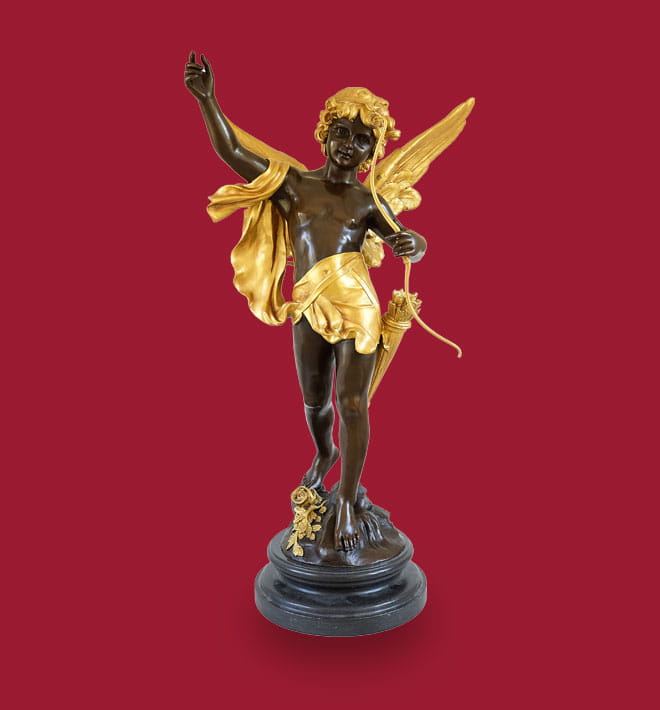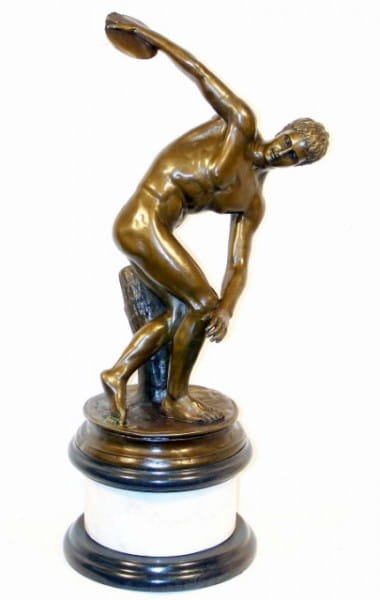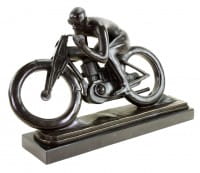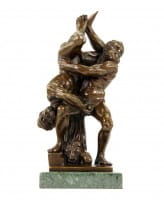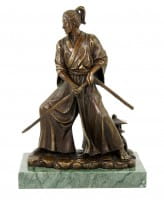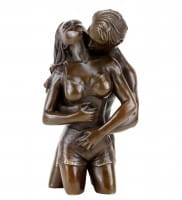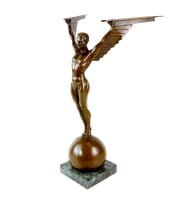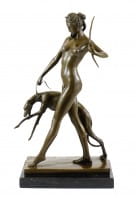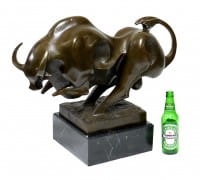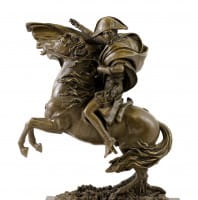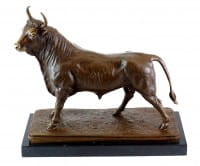Prices incl. VAT, free shipping worldwide
Ready to ship today,
Delivery time appr. 3-6 workdays










Product description
"Greek Sculpture - Discobolus Bronze Statue - by Myron"
| Weight | 17 kg |
Discobolus – The Eternal Symbol of Athletic Grace - Signed Myron
The Discobolus Bronze Statue stands as one of the most powerful symbols of classical harmony and human perfection ever conceived in sculpture. The original masterpiece was created around 455 BC by Myron of Eleutherae and captures the fleeting moment before the discus leaves the athlete's hand. The figure’s body, frozen in the midst of rotation, embodies the unity of tension and balance — a moment where physical strength meets absolute control. Myron’s understanding of anatomy and motion revolutionized Greek Sculpture, turning bronze into a living testament of movement. Through the Discobolus of Myron, the ancient world achieved a depiction of motion so vivid that it remains unsurpassed even today.
The Visionary Sculptor of Eleutherae
Myron, born around 500 BC in Eleutherae, a small town on the border between Attica and Boeotia, was among the greatest masters of the early Classical period. Very little is known about his family or upbringing, but it is believed that he trained in Athens under Ageladas of Argos, who also taught Phidias and Polykleitos. Unlike his contemporaries who focused on static perfection, Myron pursued the challenge of capturing movement and emotion within the rigid medium of bronze. His legacy lies in transforming sculpture from symbolic representation into dynamic realism. With the Discobolus of Myron, he immortalized the ideal of youthful vitality and athletic spirit that defined the Greek pursuit of excellence.
A Moment of Perfect Equilibrium
In this Discobolus Bronze Statue, the athlete’s body is twisted into a spiral of energy, each muscle anticipating the instant of release. The composition is a triumph of geometry — an interplay of circles and diagonals that creates visual rhythm and harmony. Myron’s genius lay not only in anatomical accuracy but also in the balance between tension and serenity. The face of the Discobolus of Myron remains calm and detached, reflecting the Greek belief that true mastery requires self-control. Every detail, from the tilt of the head to the flex of the wrist, embodies a poetic stillness within the storm of movement.
The Mastery of Bronze and Proportion
The choice of bronze was revolutionary, marking a defining moment in the evolution of sculpture. Unlike marble, which demanded compact and static forms for stability, bronze offered freedom — the ability to explore motion, lightness, and spatial balance with unprecedented daring. It allowed the limbs of the Discobolus Bronze Statue to extend outward in graceful tension without disrupting the harmony of the pose. The lost-wax casting technique revealed extraordinary precision, capturing every sinew and curve with lifelike clarity. Through this mastery of material, the Discobolus of Myron became more than an image of athletic beauty — it emerged as a lasting symbol of strength, movement, and the timeless perfection of the human form.
The Legacy and Rediscovery of the Discobolus
The original Discobolus of Myron has not survived, yet Roman copies made centuries later allow us to experience its magnificence. The most famous of these reproductions, found in Hadrian’s Villa in Tivoli, is preserved today in the Museo Nazionale Romano in Rome. Another renowned version can be admired in the British Museum in London, and a faithful reproduction resides in the Museo Omero in Ancona. These versions reveal subtle variations — especially in the head, which was reinterpreted in later centuries — yet all retain the extraordinary balance and vitality of Myron’s conception. The widespread admiration for the Discobolus Bronze Statue demonstrates its enduring influence as a universal symbol of athletic idealism and artistic perfection.
The Philosophical Meaning of the Athlete
For the ancient Greeks, the athlete was not simply a sportsman but a metaphor for human excellence. The Discobolus of Myron embodies the principle of kalokagathia — the harmony between moral virtue and physical beauty. The discus thrower’s concentration, precision, and composure express the discipline that defined both athletic and civic life in classical Greece. Myron’s Greek Sculpture thus transcends physical form, becoming a visual philosophy of proportion, self-mastery, and timeless grace. Through this balance of intellect and physique, the statue celebrates humanity at its most noble and inspired.
The Eternal Moment of Human Perfection
In the graceful twist of the Discobolus Bronze Statue, one sees not only the peak of athletic achievement but the embodiment of universal harmony. Myron’s mastery lies in his ability to transform motion into permanence, strength into elegance, and human effort into immortal beauty. The Discobolus of Myron continues to represent the very essence of balance — between action and repose, body and mind, humanity and divinity. Standing before it, the viewer feels the breath of ancient Greece itself — a civilization that first understood how movement could be eternal, and how perfection could be captured in bronze.
Width: 27 cm
Hight: 61 cm
Depth: 20 cm
Weight: 17 kg
100% Bronze
Our advantages
free shipping
Worldwide free shipping
14 days money back
You can cancel your order
within 14 days
secure payment services
Paypal, Master Card, Visa, American Express and more

